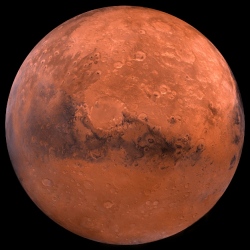
Musk said 2022 would mark the first use of the Mars Colonial Transporter, a craft that’s big enough to carry scores of people to Mars. The first MCT would be uncrewed. Elon Musk’s schedule calls for the first crewed mission to be launched in 2024, with a Mars landing in 2025.
And unlike the Apollo missions to the moon, this would not be a short-term stay. The full details of the Spacex Mars plan are expected in September.
SpaceX could also send another unmanned MCT in 2024 to accompany the manned mission. This will mean that with the 2022 mission there will be a lot of pre-positioned gear for the crewed mission. One falcon heavy with 10 tons of material at Mars in 2018 and another two Falcon heavies in 2020.
Crew return to Earth Rockets could be brought with the MCT. However, I believe that the plan will be to have the first crew proto-colonist to stay for at least two years to build up the facilities on Mars.
“I do want to emphasize this is not about sending a few people to Mars,” Elon Musk told the Post. “It’s about having an architecture that would enable the creation of a self-sustaining city on Mars with the objective of being a multiplanet species and a true spacefaring civilization, and one day being out there among the stars.”
The super-heavy lift launch vehicle for MCT will lift the 100 tonnes (220,000 lb)+ payload of the MCT into orbit and is intended to be fully-reusable. The rocket has not yet been named by SpaceX. The MCT launch vehicle will be powered by the Raptor bipropellant liquid rocket engine.
Mars Colonial Transporter has been notionally described as a large interplanetary spacecraft capable of transporting 100 people at a time to Mars, although early flights are expected to carry fewer people and more equipment. It may use a large water store to help shield occupants from space radiation and have a cabin oxygen content that is up to two times that which is found in Earth’s atmosphere.
The Mars colony envisioned by Musk would start small, with an initial group of fewer than ten people. With time, Musk hopes that such an outpost could grow into something much larger and become self-sustaining, at least 1 million people. According to Musk, "even at a million people you’re assuming an incredible amount of productivity per person, because you would need to recreate the entire industrial base on Mars. You would need to mine and refine all of these different materials, in a much more difficult environment than Earth.
There would be no trees growing. There would be no oxygen or nitrogen that are just there. No oil. ‘Excluding organic growth, if you could take 100 people at a time, you would need 10,000 trips to get to a million people,’ he said. ‘But you would also need a lot of cargo to support those people.
In fact, your cargo to person ratio is going to be quite high. It would probably be 10 cargo trips for every human trip, so more like 100,000 trips. And we’re talking 100,000 trips of a giant spaceship.
